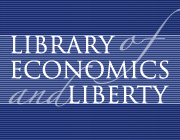
Kenneth Arrow |

Arrow went on to show, in a 1951 article, that a competitive economy in equilibrium is efficient and that any efficient allocation could be reached by having the government use lump-sum taxes to redistribute, and then letting the market work. One clear-cut implication of this finding was, and is, that the government should not control prices to redistribute income, but instead, if it redistributes at all, should do so directly. Arrow's insight is part of the reason economists are almost unanimously against price controls.
Arrow also showed, with coauthor Gerard Debreu, that under certain conditions an economy reaches a general equilibrium—that is, an equilibrium in which all markets are in equilibrium. Using new mathematical techniques, Arrow and Debreu showed that one of the conditions for general equilibrium is that there must be futures markets for all goods. Of course, we know that this condition does not hold—you cannot buy a contract for future delivery of a labor service, for example. This fact has led some economists to doubt the usefulness of Arrow's and Debreu's finding.
Arrow was also one of the first economists to note the existence of a learning curve. His basic idea was that as producers increase output of a product, they gain experience and become more efficient. Wrote Arrow: "The role of experience in increasing productivity has not gone unobserved, though the relation has yet to be absorbed into the main corpus of economic theory." Thirty years after Arrow's article, the learning curve insight has still not been fully integrated into mainstream economic analysis.
Arrow has also done excellent work on the economics of uncertainty. His work in that area is still a standard source for economists.
In 1972 Arrow, jointly with Sir John Hicks, won the Nobel Prize in economics. It was awarded for "pioneering contributions to general equilibrium theory and welfare theory."
Arrow has spent most of his professional life on the economics faculties of Stanford University (1949-68 and 1980-present) and Harvard University (1968-79).
"The Economic Implications of Learning by Doing." Review of Economic Studies 29 (June 1962): 155-73.
Essays in the Theory of Risk-Bearing. 1971.
(With Gerard Debreu.) "Existence of a Competitive Equilibrium for a Competitive Economy." Econometrica 22, no. 3 (July 1954): 265-90.
(With Frank Hahn.) General Competitive Analysis. 1971.
Social Choice and Individual Values. 1951.
